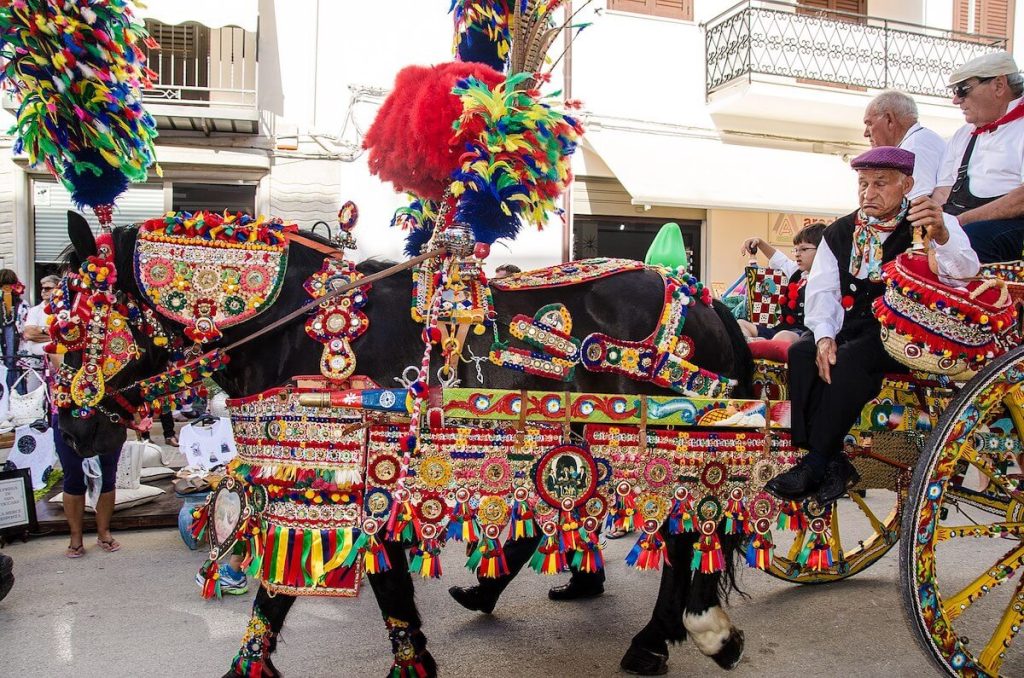Il cart It is one of symbols of Sicily. Visit the big cities of the island (Palermo e Catania first of all) and not seeing one is in fact impossible. The Sicilian cart is above all a kind of tourist attraction. However, this means of transport has had great importance over the years as a means of work. Even if the viability in Sicily hasn't evolved much (unfortunately) and several "trazzene"Rather shabby, with the spread of the automobile and other means, the cart has seen a long decline which, from the roads of the island (disastrous and otherwise), has taken it to the city centers to attract tourists or within ethnographic museums.
History of the Sicilian cart
The chariot is an ancient vehicle (almost as much as the wheel). The Sicilian cart, as it is understood today, with its typical colors and representations, was born instead at the beginning of the nineteenth century. Basically it is a cart for the freight transport, adorned with particular figures (Holy images, chivalrous and so on). This was pulled by a horse (or donkey) was used for agricultural transport and, thanks to big wheels, was ideal for facing the Sicilian "trazzere". Initially images of the Sicilian carts were painted Virgin Mary, or of the saints (in particular St. George), as a symbol of protection. Then came the images of chivalry (the work of the puppets) or mythological. At a time when most people (especially peasants) were still illiterate, the Sicilian cart also stood at "medium of culture”, Which depicted the stories that were usually told orally.

Of course, beyond the decorum, the varnish also served to protect the wood from wear and atmospheric agents. Over time the Sicilian cart, from a simple means of work, has become a real one artwork, with increasingly striking decorations. This meticulous work was entrusted to gods specialized artists, capable of painting every part of the cart (including wheels). Precisely in reference to this abundance of decorations and details (not to mention the accessories with which the driving horse was adorned) in his "Journey to Sicily" of 1885, the French writer Guy de Maupassant, described the Sicilian carts seen in Palermo as "rebus on two wheels that you always want to solve". Unfortunately today there are not many new "riddles" around. The Sicilian cart is now "past history", but fortunately it continues to live mainly thanks to tourism.
Difference between Palermo and Catania
What makes the Sicilian cart special? Certainly its ornaments, but not only. His too structure it's particular. Not all blacksmiths are able to make a cart, because of his complexity (even only for the realization of the arabesque of the "fusu box”, Which is located under the axis of the wheels). Furthermore, there is no single type of “standard” Sicilian cart. Catania and Palermo in fact have one different school of thought in this sense. Even if the basic structure is the same, the Palermitan carts have the banks (masciddari) Of trapezoidal shape, while those from Catania are rectangular. Furthermore, the former tend more to yellow, while the seconds to the red (the two colors are present since they are the colors of Sicily). In addition, there are also other less common styles, which can be found in the Agrigento, Trapani and Ragusa areas.
Museums of the Sicilian cart
Several museums have been dedicated to this ancient and magical means of transport. One of the most famous museums of the Sicilian cart is undoubtedly that of Vittoria (RG), but are also present in Bronte (CT) ad Aci Sant'Antonio (CT) and Terrasini (PA). TO Campobello di Licata (AG), the centuries-old tradition of Rieti. It is a folk festival (dedicated to Madonna dell'Aiuto), with a parade of Sicilian carts through the streets of the town. A similar parade of carts (during different holidays) also takes place in, Barry (IN), Dactyl (TP) and Canicattì (AG).
Although the Sicilian cart is now a sweet reminder of a time that was, is engraved in the hearts of all the inhabitants of the island. Even if they have never had the honor of taking a tour or have never seen an original presence, every inhabitant of the island is proud of this peasant vehicle, which has evolved into a work of art. Similarly to the Triskelion or the "Sicilian puppets”, The cart contributed to making Sicily famous all over the world, enchanting tourists who still today try to solve those riddles that Guy de Maupassant was talking about a hundred years ago.
Cover photo: © Ji-Elle - Wikimedia Commons (CC BY-SA 3.0).





